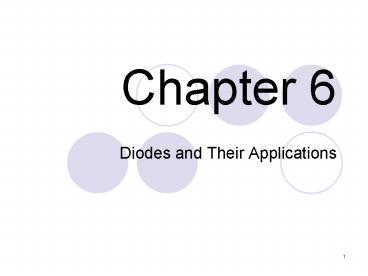Diodes and Their Applications - PowerPoint PPT Presentation
1 / 36
Title:
Diodes and Their Applications
Description:
Describe how the properties of a semiconductor differ from ... Doping and Impurities (Donors or Acceptors) P-type and N-type Material. 7. 6-2 Junction Diode ... – PowerPoint PPT presentation
Number of Views:6799
Avg rating:3.0/5.0
Title: Diodes and Their Applications
1
Chapter 6
- Diodes and Their Applications
2
Objectives
- Describe how the properties of a semiconductor
differ from those of a conductor and an
insulator. - Define donors and acceptors and discuss their
functions in creating P-type material and N-type
material. - Discuss the basic properties of a PN-junction
diode and sketch the form of the terminal
characteristic curve.
3
Objectives
- Describe the ideal model and the constant voltage
model for a junction diode and draw the
equivalent circuit forms. - Analyze simple circuit forms containing diodes
and determine when a diode is forward biased or
reverse biased. - State the input-output properties of an ideal
transformer in terms of the turns ratio.
4
Objectives
- Draw the schematic diagram of a half-wave
rectifier and analyze its operation. - Draw the schematic diagram of a full-wave
rectifier with a center-tapped secondary and
analyze its operation. - Draw the schematic diagram of a full-wave bridge
rectifier and analyze its operation. - Describe the function of a rectifier filter and
analyze the ripple level.
5
Objectives
- Define peak inverse voltage and determine its
value for different rectifier circuits. - Discuss the properties of different types of
diodes. - Draw the schematic diagram of a zener regulator
circuit and analyze its operation.
6
6-1 Semiconductor Concepts
- Conductors, Insulators, and Semiconductors
- Electrons or Holes
- Doping and Impurities (Donors or Acceptors)
- P-type and N-type Material
7
6-2 Junction Diode
- Schematic Symbol
- Applications
- Terminal Characteristic
8
PN-junction diode and its schematic symbol.
9
Ideal resistance and its terminal characteristic.
10
Experiment used to determine semiconductor diode
terminal characteristic.
11
Form of the terminal characteristic of a
semiconductor diode.
12
6-3 Diode Circuit Models
- Ideal Diode Model
- Constant Voltage Model
- Other Models
- Which Model is Appropriate?
- Is a Diode Forward Biased or Reverse Biased?
13
Ideal diode model and terminal characteristic.
14
Constant voltage diode model and terminal
characteristic.
15
Circuit of Example 6-1.
16
Circuit of Example 6-2.
17
6-4 Diode Rectifier Circuits
- Why Convert AC to DC?
- Half-Wave Rectifier Circuit (Unfiltered)
- Full-Wave Rectifier Circuit (Unfiltered)
- Full-Wave Rectifier Bridge
18
A half-wave rectifier without filtering and the
waveforms.
19
Schematic diagram of an unfiltered full-wave
rectifier with a center-tapped transformer and
the waveforms.
20
Conduction models for full-wave rectifier with
center tap for alternate half-cycles.
21
Schematic diagram of an unfiltered full-wave
bridge rectifier circuit.
22
Conduction models for bridge rectifier for
alternate half-cycles.
23
6-5 Rectifier Circuits with Filtering
- Half-Wave Rectifier with Capacitor Filter
- Full-Wave Rectifiers with Capacitor Filter
- Ripple Analysis
- Reverse Diode Voltage
- More Complex Filter Circuits
- Power Supplies with a Voltage Regulator
24
Schematic diagram of a basic half-wave rectifier
circuit with transformer and capacitor filter.
25
Waveforms for half-wave rectifier with
transformer and filter.
26
Schematic diagram of a full-wave rectifier
circuit with transformer and capacitor filter.
27
Schematic diagram of a full-wave bridge rectifier
circuit with capacitor filter.
28
Waveforms for full-wave rectifier without and
with filter.
29
Schematic diagram of a rectifier circuit with
voltage regulator.
30
6-6 Survey of Other Diode Types
- Zener Diode
- Light Emitting Diode
- Photodiode
- Optocoupler
- Schottky Diode
- Varactor Diodes
31
Schematic symbols for various types of diodes.
32
6-7 Zener Regulator Circuits
- Qualitative Explanation
33
Typical zener regulator circuit.
34
Circuit of Example 6-8 with voltage and current
values labeled.
35
Circuit of Example 6-9 with voltage and current
values labeled.
36
Circuit of Example 6-10 with voltage and current
values labeled.































